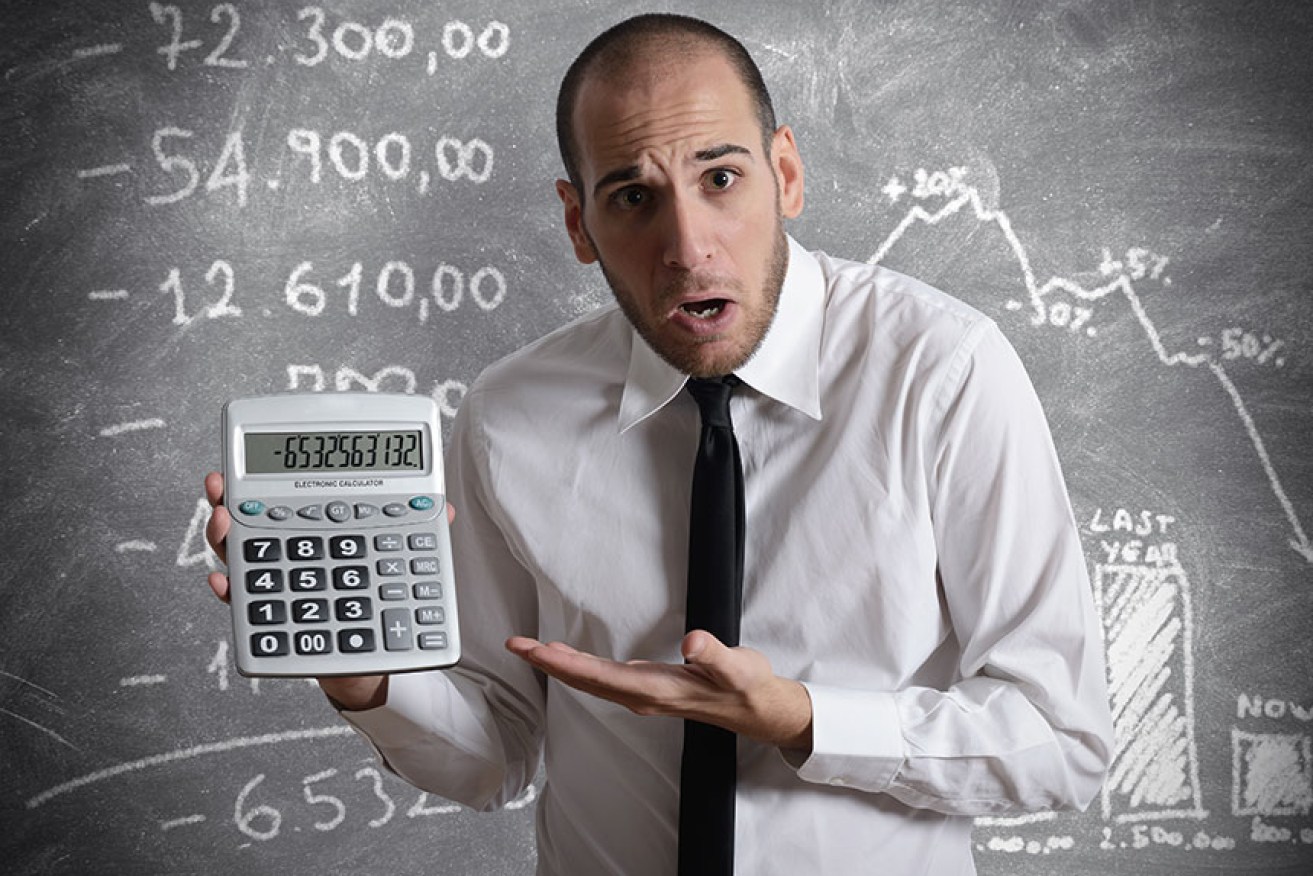Why you can’t afford to be bad at maths

ShutterStock
Mathematics can bewilder people, but it’s not like it creates incalculable suffering.
That’s because the sum of the misery and end product of the angst has now been crunched, totalled and converted into dollars.
And, how’s this for a big, negative number – $21 billion! That’s what crook maths skills are costing us. Go figure.
Even people who enjoy maths, one bad teacher kills it for them
For many Australians, the closest they get to algebra is watching the X Factor and wondering, Y?
New research has found that nine in every 25 adults feel they’ve been dragged back in life by poor maths skills, significantly and personally number-crunched.
Put that with other research that says people wildly overestimate their maths prowess and that they very readily shrug and surrender to this deficiency. It’s a grim equation.
Last month, world-first British research put the cost of numerical illiteracy there at between 1.3 and 2.2 per cent of GDP. It doesn’t sound all that much, does it? Get out your pens.
The British GDP is $2.6 trillion. That is twenty six with eight zeros, one zero for each of your fingers, thumbs excepted. In a stack of dollar coins it would reach 78,000km high, 130 times higher than the Hubble Space Telescope.
A pesky 1.3 per cent of that would still pass the telescope by 400km. In dollars, it is about 34 billion. The 2.2 per cent turns into $57 billion.
If you think we are ok, that we are smarter than Brits – perhaps you sat near the Barmy Army at the cricket? – well, sorry. That’s one mark off.
An OECD report last year found our numeracy was in line with similar nations. Call it a common denominator.
Just over one adult in five couldn’t perform calculations with whole numbers and decimals or manage simple measurements. In a decade our maths has slipped the equivalent of wagging six months of school.
The Australian Council for Educational Research says the two major world studies into numeracy show Australia’s maths standard is, at best, treading water.
“They tend to show Australia is fairly similar to other English speaking nations,” ACER spokesman Steve Holden says.
Mathematical Association of Victoria chief executive Simon Pryor says part of the problem is a vicious supply and demand circle. A shortage of maths whizzes bumps up their commercial value and prices them out education. A lack of great maths teachers perpetuates the shortage.
“Even people who enjoy maths, one bad teacher kills it for them,” he says.
While wary of the “dark art” of economics, the UK study “resonates with our own experience”.
Mr Pryor says mathematics is becoming more important in a world of Big Data and mathematical modelling. The search for missing flight MH370 boiled down to “mathematical stuff”.
“(A maths skill shortage) is seen as an acute issue in many western countries now,” he said.
“A modern economy like Australia, we can’t keep digging holes forever.”
So, assuming Australia has a GDP, how much, and how, is bad maths costing us?
Sloppy maths hits your hip pocket. Bad guestimates waste money. You make up the weed killer too strong and throw out food you were never going to use in time. Power and phone companies see you coming. Your trousers are too snug. (What’s inches to cm again?) Finance companies send you Christmas cards. You peak early at work, slump early in life, so research says.
If, like one in six Brits, you are unable to work out which number on your bank statement is the balance, you’re in even deep trouble.
Now, multiply those monetary glitches and bad financial choices by roughly six million to create a fiscally dysfunctional household as big as our wide brown land.
Our GDP is about $1.65 trillion. Imagine a stack of 80 Gina Rineharts. The 1.3 per cent of that would be $21.4 billion, one Gina, in a hat. The 2.2 per cent estimate pushes it out to $36 billion.
So, how do they work out bad maths causes such big numbers? They estimate the pay rises people forfeit by being restrained by their maths, the tax the government misses out then and the cost of one business in five struggling to find mathematically-skilled staff.
To reach the more-rubbery 2.2 per cent of GDP, Pro Bono Research factored in the social costs.
Poor maths skills coincided with depression and perceived physical decline. The numerically challenged smoke more and enjoy life less – at least on average.
More than one-fifth lacked confidence investing, seemingly with every reason.
One quarter of the jail population had the number skills of a seven year old or below. Almost two-thirds of prisoners were less numerate than an 11 year old.
A modern economy like Australia, we can’t keep digging holes forever
The UK study defined low numeracy as primary school level and below. It was part of a push to get maths slouches back to their books or to at least spend 20 minutes testing their numeracy.
National Numeracy, who commissioned the UK study by Pro Bono Economics, says half the working population there have the maths skills expected of a primary school child.
So, to the $64,000 question, or whatever the adjusted number is these days. What do we do?
Number crunching – a quiz
Questions
Standard of an eight year old
Q1: The sum of Jim and Joe’s ages is 61. Joe is one year older than Jim. How old is Jim?
Q2: The bus will take one hour then the train will take two-and-a-half hours. You need to allow half an hour to change between them. How long will the journey take?
Standard of nine to 11 year olds
Q3: I decided to save $10 in January and then double the amount each month. How much will I need to save in April?
Q4: Jeff spent these amounts on food. Work out how much it cost per item. You may use a calculator.
a) Four tomatoes cost 80 cents, so each tomato costs?
b) Six rolls cost 72 cents so each roll costs?
c) Six eggs cost $1.80 so each egg costs?
Lower secondary school standard, 12-14 years
Q5: A knockout poker tournament starts with 64 contestants. How many rounds must be played before a champion is found?
Q6: John is planning to go for a walk in the country. The map uses a scale of 1:50,000 (2cm = 1km). He wants to walk for 20km.
a) How many cm is this on the map?
b) If he plans a route which is 50cm on the map, how many km will this be?
Higher secondary school standard, 15-plus
Q7. Five years ago there were 25 people in the office, and the ratio of men to women was 3:2. Since then five men and five women have joined. What is the new ratio of men to women?
Q8. Sian bought a TV in the January sales that had been reduced by 20 per cent. She paid $290 for it. What was the original price?
Answers
Q1. 30
Q2. Four hours
Q3. $80
Q4.
a) 20c
b) 12c
c) 30c
Q5. 6 rounds
Q6.
a) 40cm
b) 25km
Q7. 4:3
Q8. $362.50
Source: nnchallenge.org.uk










